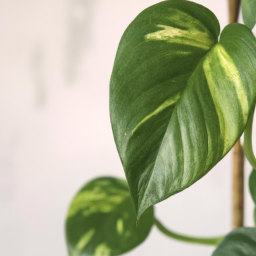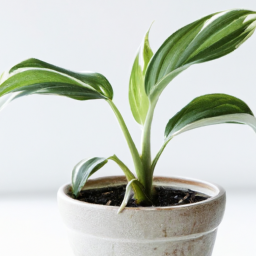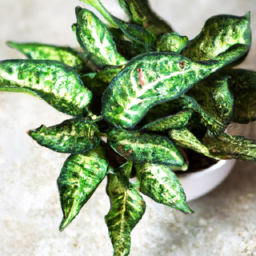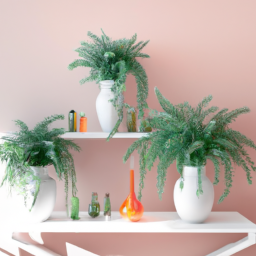
Are you considering bringing some greenery into your home but wondering if indoor plants are safe? You’re not alone! Many people have concerns about the potential risks associated with having plants indoors. In this blog post, we will explore the topic of indoor plants and whether they are safe to have in your home. We’ll discuss the benefits of indoor plants, potential risks to be aware of, and tips for keeping your indoor plants healthy and safe. So, let’s dive in and find out if indoor plants are indeed safe for your living space.
Benefits of Indoor Plants: Is It Safe to Have Them in Your Home?
The Benefits of Indoor Plants
Indoor plants are not only aesthetically pleasing, but they also offer a range of benefits that can improve your overall well-being. One of the main benefits of indoor plants is their ability to purify the air. Plants absorb carbon dioxide and release oxygen through photosynthesis, which can help improve the air quality in your home. This can lead to better respiratory health and overall improved air quality.
In addition to purifying the air, indoor plants can also help reduce stress and improve your mood. Studies have shown that being around plants can help lower blood pressure, reduce anxiety, and increase feelings of calmness and relaxation. Having plants in your home can create a sense of tranquility and connection to nature, which can be beneficial for your mental health.
Furthermore, indoor plants can improve concentration and productivity. Research has shown that having plants in indoor spaces can help increase focus and cognitive function. This can be especially beneficial for those who work from home or spend long hours indoors. Plants can also help reduce noise levels and create a more peaceful environment, which can further enhance productivity and overall well-being.
Overall, the benefits of indoor plants are numerous and can have a positive impact on both your physical and mental health. From purifying the air to reducing stress and improving concentration, having plants in your home can enhance your overall quality of life.
Is It Safe to Have Indoor Plants in Your Home?
While indoor plants offer a range of benefits, it is important to consider whether they are safe to have in your home, especially if you have pets or young children. Some indoor plants can be toxic if ingested, so it is important to research the plants you are considering and ensure they are safe for your household.
If you have pets, it is important to choose non-toxic plants that are safe for them to be around. Some common indoor plants that are safe for pets include spider plants, Boston ferns, and African violets. It is also important to place plants out of reach of pets to prevent them from being chewed on or ingested.
In addition to considering the toxicity of plants, it is also important to consider your own allergies and sensitivities. Some people may be allergic to certain types of plants, which can cause respiratory issues or skin irritation. If you have allergies, it is important to choose plants that are less likely to trigger a reaction, such as succulents or air plants.
Overall, while indoor plants offer a range of benefits, it is important to consider the safety of having them in your home. By choosing non-toxic plants, placing them out of reach of pets, and considering your own allergies, you can enjoy the benefits of indoor plants without compromising the safety of your household.
Tips for Caring for Indoor Plants
Once you have chosen safe indoor plants for your home, it is important to properly care for them to ensure they thrive and continue to provide you with their benefits. Here are some tips for caring for indoor plants:
1. Water your plants regularly, but be careful not to overwater them. Most indoor plants prefer to dry out between waterings, so it is important to check the soil moisture before watering.
2. Place your plants in a location that receives adequate sunlight. Most indoor plants prefer bright, indirect light, so it is important to place them near a window where they can receive sunlight without being exposed to direct sunlight.
3. Dust your plants regularly to keep their leaves clean and allow them to photosynthesize effectively. You can use a damp cloth or a gentle spray of water to clean the leaves and remove any dust buildup.
By following these tips and properly caring for your indoor plants, you can enjoy their benefits and enhance the overall well-being of your home. Indoor plants can bring a sense of calmness, improve air quality, and enhance the aesthetics of your space, making them a valuable addition to any home.

Common Indoor Plants That Are Safe for Pets and Children
Introduction
When it comes to choosing indoor plants for your home, safety is always a top priority, especially if you have pets or children. Many common indoor plants can be toxic if ingested, so it’s important to choose plants that are safe for your furry friends and little ones. In this guide, we will discuss some of the most popular indoor plants that are safe for pets and children, so you can enjoy the beauty of nature in your home without worrying about any potential dangers.
Pet-Friendly Plants
One of the most popular pet-friendly indoor plants is the spider plant (Chlorophytum comosum). This plant is safe for cats and dogs and is easy to care for, making it a great choice for pet owners. Another pet-friendly option is the Boston fern (Nephrolepis exaltata), which is non-toxic to pets and adds a touch of greenery to any room. The African violet (Saintpaulia) is also safe for pets and adds a pop of color to your home.
If you’re looking for a low-maintenance plant that is safe for pets, consider the parlor palm (Chamaedorea elegans). This plant is non-toxic to cats and dogs and thrives in low light conditions. The friendship plant (Pilea involucrata) is another pet-friendly option that is safe for cats and dogs and is easy to care for.
When choosing pet-friendly indoor plants, it’s important to consider the habits of your furry friends. Some pets may be more prone to chewing on plants, so it’s best to place them out of reach or choose plants that are safe if ingested.
Child-Safe Plants
When it comes to choosing indoor plants that are safe for children, there are several options to consider. The spider plant is not only safe for pets but is also non-toxic to children, making it a great choice for families with young kids. The Christmas cactus (Schlumbergera) is another child-safe plant that adds a festive touch to your home during the holiday season.
If you’re looking for a plant that is safe for children and easy to care for, consider the jade plant (Crassula ovata). This succulent is non-toxic to kids and adds a modern touch to any room. The nerve plant (Fittonia) is another child-safe option that is safe for kids and adds a pop of color to your home.
When choosing child-safe indoor plants, it’s important to consider the placement of the plants in your home. Some plants may have sharp or prickly leaves that could pose a hazard to curious little hands, so it’s best to choose plants with soft foliage or place them out of reach of children.
In conclusion, there are many indoor plants that are safe for pets and children, allowing you to enjoy the beauty of nature in your home without any worries. By choosing pet-friendly and child-safe plants, you can create a safe and inviting environment for your furry friends and little ones to enjoy.

Tips for Ensuring the Safety of Indoor Plants in Your Home
Understanding the Potential Risks
When it comes to having indoor plants in your home, it’s important to be aware of the potential risks they can pose. While plants can bring beauty and a sense of nature indoors, some plants can be toxic if ingested. This is especially important to consider if you have young children or pets in your home who may be curious and prone to exploring their surroundings.
It’s also important to consider the potential risks of mold and pests that can be attracted to indoor plants. Mold can thrive in the moist soil of potted plants, especially if they are overwatered. Pests such as spider mites, aphids, and fungus gnats can also be attracted to indoor plants, which can be a nuisance to deal with and can potentially harm the plants if left unchecked.
To ensure the safety of indoor plants in your home, it’s important to be aware of these potential risks and take steps to mitigate them.
Choosing Safe Plants for Your Home
One of the best ways to ensure the safety of indoor plants in your home is to choose plants that are non-toxic and safe for both humans and pets. Some popular indoor plants that are safe to have in your home include spider plants, Boston ferns, and African violets. These plants are not only safe, but they are also relatively easy to care for and can thrive in indoor environments.
When selecting plants for your home, it’s important to do your research and ensure that the plants you choose are safe for your specific situation. If you have young children or pets, it’s best to avoid plants that are known to be toxic if ingested. Additionally, consider the lighting and humidity levels in your home to ensure that the plants you choose will thrive in their new environment.
Maintaining Healthy Indoor Plants
Once you have chosen safe plants for your home, it’s important to maintain their health to ensure they continue to thrive and remain safe. Proper watering, lighting, and fertilizing are key components of plant care that can help prevent issues such as mold and pests.
Overwatering is a common issue that can lead to mold growth and root rot in indoor plants. To prevent this, make sure to water your plants only when the top inch of soil is dry to the touch. Proper lighting is also essential for indoor plants to thrive, so make sure to place them in a location where they will receive adequate sunlight or artificial light.
Regularly inspecting your plants for signs of pests or disease is also important for maintaining their health. If you notice any issues, such as yellowing leaves or strange spots, take action immediately to prevent further damage to your plants.
By following these tips for ensuring the safety of indoor plants in your home, you can enjoy the beauty of nature indoors while keeping your family and pets safe. Remember to research the plants you choose, maintain their health, and be aware of potential risks to create a safe and healthy environment for your indoor plants.
In Summary
Many people love having indoor plants in their homes for their aesthetic appeal and potential health benefits. However, some may be concerned about the safety of having plants indoors, especially if they have pets or young children. The good news is that most indoor plants are safe to have around, as long as you take some precautions.
While some plants can be toxic if ingested, the likelihood of this happening is low as long as you keep them out of reach of pets and children. It’s also important to research the specific care requirements of each plant to ensure they are being properly cared for. Overall, having indoor plants can improve air quality, reduce stress, and add a touch of nature to your living space, making them a safe and beneficial addition to your home.
Common Questions and Answers:
Q1. Are indoor plants safe to have in my home?
A1. Yes, indoor plants are generally safe to have in your home. They can help improve air quality, reduce stress, and add a touch of nature to your indoor space.
Q2. Can indoor plants be toxic to pets?
A2. Some indoor plants can be toxic to pets if ingested. It’s important to research and choose non-toxic plants if you have pets in your home. Keep toxic plants out of reach of pets or opt for pet-friendly plants.
Q3. Do indoor plants attract pests or insects?
A3. Indoor plants can attract pests or insects if not properly cared for. Overwatering, poor drainage, or lack of sunlight can create a hospitable environment for pests. Regularly inspect your plants for signs of pests and take preventive measures.
Q4. Can indoor plants cause allergies or respiratory issues?
A4. While indoor plants can improve air quality, some people may be allergic to certain plants or their pollen. If you have allergies or respiratory issues, choose plants that are less likely to trigger your symptoms, such as plants with minimal pollen production.
Q5. How do I ensure the safety of indoor plants in my home?
A5. To ensure the safety of indoor plants in your home, research the specific care requirements of each plant, including watering, sunlight, and temperature needs. Keep toxic plants out of reach of children and pets, regularly inspect for pests, and provide proper ventilation for healthy plant growth.
Dr. Olivia Green is a botanist with over two decades of experience in indoor plant cultivation. She holds a Ph.D. in Plant Biology and has dedicated her career to researching plant behavior in controlled environments. Dr. Green is passionate about helping plant enthusiasts master the art of indoor gardening through her extensive knowledge and practical insights.


